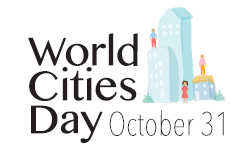



Good urban form is the foundation for sustainable cities, and urban design is the tool that provides the opportunity to transform the way that we live, to facilitate the development of socially integrated, prosperous cities where people live together.
Urban form is the combination of streets, building typologies and networks of public spaces. They form the underlyin structure of the city, a skeleton around which people’s lives are built and activities carried out. Urban form affects how we live, how we move around, how our neighbourhoods look like and how safe we feel on the streets.
The fame and familiarity of many cities is owed to their urban form. Venice’s narrow passageways and canals allow a slower pace of life and an intimate familiarity amongst its residents. New York’s quick-paced life and character is linked to its big, busy orthogonal avenues, tall buildings and high density of inhabitants. The vibrant and lively community life in Marrakesh is fostered in the narrow, dense streets filled with commercial activities. But not only the examples of good design capture the imagination. In many contexts, the sprawled structure of cities has created a culture dependent on cars. And the contemporary cities with enclosed residential-only neighbourhoods with small street frontage have created streets that are inactive, dark and unsafe at night. Design that supports density, street life and connectivity, facilitates mixed use, enables a mix of social groups and is adapted to local and cultural contexts is a great tool to support sustainable cities and livability.
Good design contributes to social integration, equality and diversity. Planning residential areas with different possibilities in terms of typology and price enables residents from different backgrounds and income levels to live together, prevents the creation of isolated ghettos or gated communities, fights segregation and discrimination. Good design gives space for different cultures, ethnicities, lifestyles to mix and come together.
Good design fosters sustainable use of shared resources. Planning compact, denser cities reduces the overexploitation of natural resources, and facilitates common living by enabling equal access to land, food and water for all.
Good design inspires lively neighborhoods. Designed public spaces, parks, playgrounds, streets and squares filled with activities help create a vibrant public life for all residents.
Good design can make cities safer. Neighbourhoods that remain active and lively at night, with commercial activities on the ground floors, pedestrian friendly well-lit streets and public spaces mean increased personal safety and security.
Good design fosters proximity to jobs and services. With good infrastructure and public transport, higher building density and mixed use neighbourhoods, jobs, markets, schools and recreation are closer to people’s homes and are easily accessible by foot, bike or public transport.
Good design helps to create clean, healthy cities. Denser cities and proximity to jobs and services mean reduced need for car use, less congestion and less pollution, as well as more sustainable usage of land and preservation of the natural and green areas.
Good design anticipates climate change and reduces the impacts of disasters. Planning with sensitivity to the surrounding nature, avoiding development in risky zones, planning natural buffers and prevention systems in flood or earthquake prone areas builds resilient settlements and safe communities.
Design as a participatory process
Good design means building an integrated all-encompassing urban system that considers not only what the urban form of the city should be, but also what should be the process of envisioning it.
In many cities, planning mechanisms are rigid and linear. Design is here thought of as final stage of planning, as giving form to a long process of complicated research. Outsourced to specialized consultants, it is the endeavour of a technocratic club -- members only.
Yet the true power of design lies in bringing people together in a process that is inclusive, transparent and iterative in character. In a city, demands and desires of many different stakeholders need to be combined and balanced, as negotiation is the cornerstone of many planning decisions. A traffic engineer advises wide roads, the private sector presses for space for business, politicians dream of great civic squares and inhabitants demand quality affordable residences. Design is thus the combined process of distilling the needs of different stakeholders in a concrete proposal.
When planning cities, public authorities should facilitate a collaborative design process with a broad range of concerned stakeholders, that develops a debate around concrete interventions, step by step. Design is the point of departure from which through debate and reflection, testing and improving, a common vision is reached. If design is integrated throughout the whole process -- from research phase to detailed phase -- it can propose tangible negotiable directions, define problems and provide momentum to every phase of planning. Clear design also makes planning accessible for non-planners, who can be put-off by technical jargon, and encourages them to actively contribute to the process. As clear design facilitates understanding by politicians and civic society, it can also accelerate governments’ decision-making processes and save endless deliberations.